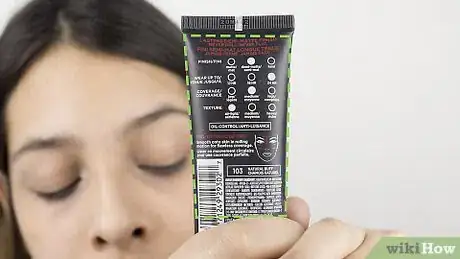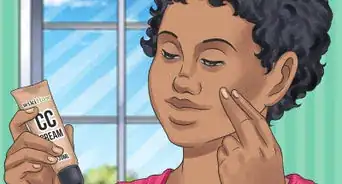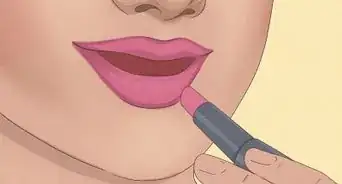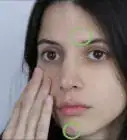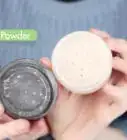This article was co-authored by Cassandra McClure. Cassandra McClure is a clean beauty advocate, working to increase use of sustainable and healthy cosmetics, based in Palo Alto, California. She has worked in the beauty and cosmetic industries for over 15 years, as a model, makeup artist, and entrepreneur. She has a Masters in High Definition Makeup from the MKC Beauty Academy.
There are 14 references cited in this article, which can be found at the bottom of the page.
wikiHow marks an article as reader-approved once it receives enough positive feedback. In this case, 89% of readers who voted found the article helpful, earning it our reader-approved status.
This article has been viewed 430,410 times.
Many people choose to wear makeup every day, either to cover up blemishes or simply enhance their natural beauty. However, coming up with a makeup routine when you're just starting out can be a daunting task. Knowing which products to use and in what order seems complicated and time-consuming, but is actually very simple and easy to master. Breaking down your routine into smaller steps will help.
Steps
Preparing Your Face
-
1Start out with a completely clean face. The very first part of your routine is to clean your face. Use a washcloth, soap, and warm (but not hot) water to gently wash your face. If you shower in the morning and already scrubbed your face, you can of course skip this step.
- It's even more important to make sure your face is clean at the end of the day. Always be sure to remove your makeup before you go to bed. Leaving it on overnight can clog your pores and cause acne. Many dermatologists recommend using disposable exfoliating wipes to remove makeup.[1]
-
2Apply sunscreen and moisturizer. If you plan on spending time in the sun, be sure to start with some sunblock. Use a product made especially for faces, as these are less likely to leave goopy residue that makes applying makeup difficult. If your skin is prone to dryness and flaking, be sure to massage in a dollop of moisturizer. Makeup can temporarily disguise flakey skin, but will be obvious and look even worse by the end of the day. If you need both, apply your sunscreen first.[2]Advertisement
-
3Apply makeup primer to your face. Primer helps makeup go on easier and last longer. Simply dab some onto your fingertips to apply it. Work the primer into your skin wherever you plan on wearing makeup. If you'll be wearing foundation, this means your forehead, nose, chin, and cheeks.
- If you'll be wearing eyeliner or eyeshadow, add some primer to your eyelids and the space underneath your eyebrows. General makeup primer usually works fine in these areas. However, more gentle primers designed especially for eyelids are also available.[3]
Putting Down the Foundation
-
1Choose the right foundation. Foundations come in many varieties, each offering different benefits and drawbacks. While some use solid foundation sticks, liquid foundations tend to be the more popular option.
- Finding the right foundation can be a challenge. You want one that best matches your natural skin tone.
- If your skin is prone to irritation, you'll need to look for foundations that are advertised as "gentle" and "for sensitive skin."
- Additionally, quality foundation is expensive, so you may not be able to afford trial and error. When choosing a new foundation, try talking to beauticians at a makeup counter in a department store or cosmetics shop. They will most likely offer to do your makeup for free. They'll pick out the perfect shade to match your skin tone, and you can get an idea of how different products feel on your skin. Don't feel obligated to buy anything that day.
-
2Apply foundation. A thin, even layer of foundation will work to smooth out your skin and give it a uniform appearance. How you apply your foundation will be determined by the type you've chosen.
- For liquid or cream foundations, start by adding a very small dollop close to the center of your face (such as the side of your nose) and apply it outward. You may use your fingertips, a foundation brush, or a makeup sponge. Add more as needed. Don't massage the foundation into your skin. Instead, use light, stroking movements as if you were painting on a canvas.[4]
- Most solid foundations come as a tube or stick. For these, you can either use your fingers to pick up some product and apply as you would a liquid, or you can use the stick directly on your skin. Applying directly from the stick to your skin will give you better coverage but will result in a thicker layer.
- No matter which type of foundation you use, it's important to blend your makeup well to make it look natural. Use small circular motions with your applicator of choice until it looks seamless on your skin.
-
3Add some concealer to problem areas. If you have any uneven areas that show through your foundation, such as pimples or dark circles under your eyes, you can cover them up with a little concealer. Dab a tiny amount to these areas and blend the concealer using the same technique you used for your foundation.[5]
- Choose a concealer the same way you would a foundation. Unlike foundation, however, it's good to pick a concealer that is one or two shades lighter than your natural skin tone. Because it doesn't have to be exact, testing concealer on your hand can help you narrow down your choices.
-
4Brush on some translucent powder. When using foundation, you should always finish with a powder. This will help your makeup to set, making it last longer and keeping it from rubbing off. Use a brush to lightly dust on some translucent powder to your forehead, cheeks, nose, and chin.[6]
Adding Color
-
1Apply blush and/or bronzer. Blushes and bronzers are both pigmented powders designed to enhance your skin. Blush is meant to add a healthy, slightly flushed look to your cheeks, while bronzer gives your skin a sun-kissed appearance. Both are meant to be used on the cheeks, but you can also apply bronzer to your nose, chin, and forehead. Use a rounded makeup brush to dust either one (or both) onto your skin.
- As with other types of makeup, there are certain things to keep in mind when picking a bronzer or a blush. For bronzer, choose a relatively neutral shade that is just a little darker than your natural skin tone. For blush, try to match the color your skin turns when it's flushed. For lighter skin tones, go for pinks and peaches. Good blush colors for medium skin are a muted mauve, rose, apricot, or berry. On dark skin, dramatic colors like raisin, brick red, and bright tangerine work best. They may seem too bold for an everyday makeup, but these colors will end up looking subtle and neutral when applied to darker skin tones.
- Some people use bronzer to contour their cheekbones. If you're going this route, you'll need at least two shades of bronzer: one a little lighter than your natural skin color and one a little darker. Use a clean makeup brush to add the lighter shade first to your cheekbones. Then follow up with the darker shade underneath. Use a brush to blend both together with the rest of your makeup for a natural look.
-
2Apply an eye primer. If you haven't primed your eye area, make sure to do so before you begin putting on your eyeshadow. Use your fingertips to massage in a small amount of primer onto your eyelids and the area just above your eye crease. You can use either the same primer you used for the rest of your face or a specialty eye primer. When using a face primer, check its packaging to make sure it's safe for eyes.
-
3Pick your eyeshadow colors. You'll need at least two colors to start, with one darker than the other. Think about the look you want to have. When it comes to eyeshadow, you have three general options:
- The natural look. With this look, many people won't even notice you're wearing eye makeup. Pick colors that are close to your skin tone. Use a neutral eyeshadow palette made up of peaches, olives, tans, and/or browns.
- The smoky look. For smoky eyes, you'll definitely look like you're wearing makeup. However, this is a very popular look right now with many people incorporating it into their everyday makeup. Use a palette of dark grays and charcoals. Avoid true black eyeshadow, as it's difficult to create depth when working with black.[7]
- The colorful look. For this, anything goes. Pick your favorite color or one that compliments your eyes. For shadows, use either a darker version of this color or a smoky charcoal.
-
4Apply the lightest eyeshadow first. This will serve as your base color. Depending on the look you want, apply your base to just your eyelid or from your eyelid to your eyebrows. Use either a thin makeup brush or an eyeshadow applicator.
-
5Apply the darker eyeshadow to your lids. Cover the entire eyelid but stop at your eye crease. Start from your lash line and brush the eyeshadow up to your eye crease. Blend it well with your base color using the same circular "buffing" motions you used for your foundation.
-
6Make your eyes pop with a little eyeliner. You can use an eyeliner pencil, brush on liquid eyeliner, or layer the liquid over the solid.[8] Use black or dark brown. If you're going for a colorful look, you may choose to use a darker version of your eyeshadow's shade instead.
- Begin by marking your lashline. Start from the outside corner of your eye and work inwards towards your nose.[9]
- Even out the line with the smudging tool on the other side of your eyeliner. Simply go back over the pigment until you have one continuous, gapless line of dark color. If your eyeliner doesn't have a smudger, use a cotton swab instead.[10]
- Many people apply eyeliner to just their upper lid. However, if you choose to do both lids, make sure the liner connects at the outer corners of your eyes.[11]
-
7Put the finishing touches on your eyes. When doing your eye makeup, you'll want to focus on your lashes last. Curling your lashes will make them look much longer. Be sure to position your curler at the base of your lashes near the lashline for the best effect. Add a swipe of mascara afterwards.[12] You can always skip the curler and wear mascara on uncurled lashes.
-
8Add lip color or gloss. Just like your eyeshadow, you will have to choose between natural-looking lip colors and ones that are obviously makeup. For everyday makeup, most people like to go with neutral pinks and browns that are closest to their natural lip color. Others like to add classic red or plum lipstick. Still others eschew color altogether and simply apply some clear lip gloss or lip balm. It's up to you to decide what look is right for you.
- Regardless, you should add your lip color last when all of your other makeup has dried. Bring your product with you in case you need to refresh it later in the day.
- Many people simply apply their lip color of choice and blot their lips. However, there are a few tricks you can use to make application easier and look more professional.
- Start by adding foundation or lip balm to your lips to act as a primer for your lip color.
- Sketch out your lip line with a neutral pencil before adding your color. This will help you define your lips and avoid sloppy application.[13]
Expert Q&A
Did you know you can get expert answers for this article?
Unlock expert answers by supporting wikiHow
-
QuestionHow do I make my makeup look smooth?
 Cassandra McClureCassandra McClure is a clean beauty advocate, working to increase use of sustainable and healthy cosmetics, based in Palo Alto, California. She has worked in the beauty and cosmetic industries for over 15 years, as a model, makeup artist, and entrepreneur. She has a Masters in High Definition Makeup from the MKC Beauty Academy.
Cassandra McClureCassandra McClure is a clean beauty advocate, working to increase use of sustainable and healthy cosmetics, based in Palo Alto, California. She has worked in the beauty and cosmetic industries for over 15 years, as a model, makeup artist, and entrepreneur. She has a Masters in High Definition Makeup from the MKC Beauty Academy.
Makeup Artist
-
QuestionWhat you need for an everyday makeup look?
 Cassandra McClureCassandra McClure is a clean beauty advocate, working to increase use of sustainable and healthy cosmetics, based in Palo Alto, California. She has worked in the beauty and cosmetic industries for over 15 years, as a model, makeup artist, and entrepreneur. She has a Masters in High Definition Makeup from the MKC Beauty Academy.
Cassandra McClureCassandra McClure is a clean beauty advocate, working to increase use of sustainable and healthy cosmetics, based in Palo Alto, California. She has worked in the beauty and cosmetic industries for over 15 years, as a model, makeup artist, and entrepreneur. She has a Masters in High Definition Makeup from the MKC Beauty Academy.
Makeup Artist
-
QuestionI'm terrible at makeup and this article has helped, but I'm the worst at eyeliner; what should I do?
 Cecilia FloresTop AnswererTo me, gel liner is the easiest. It comes in a little jar and you need an angled brush to apply it. It's not a liquid, so fixing mistakes is easier. Pencil liner is also nice if you can sharpen it.
Cecilia FloresTop AnswererTo me, gel liner is the easiest. It comes in a little jar and you need an angled brush to apply it. It's not a liquid, so fixing mistakes is easier. Pencil liner is also nice if you can sharpen it.
References
- ↑ http://health.usnews.com/health-news/articles/2012/07/25/beware-of-these-hidden-causes-of-acne
- ↑ http://www.theglow.com.au/beauty/which-face-product-goes-on-first/
- ↑ http://www.huffingtonpost.com/2015/01/16/what-is-makeup-primer_n_6463190.html
- ↑ http://jezebel.com/5503922/beauty-101-your-foundation-and-concealer-concerns-answered
- ↑ https://deliver.glamour.com/story/beauty-tips-how-to-do-foundation-like-a-pro-2011-02
- ↑ http://www.webmd.com/beauty/skin-glow-13/no-makeup-look
- ↑ http://hollywoodlife.com/2015/09/22/emmy-awards-smokey-eye-how-to-best-beauty-emmys-2015/
- ↑ http://www.elle.com/beauty/makeup-skin-care/how-to/a31898/how-to-apply-liquid-eyeliner
- ↑ http://www.oprah.com/style/How-to-Put-On-Eyeliner-The-Right-Way-to-Apply-Eyeliner/2
- ↑ http://www.oprah.com/style/How-to-Put-On-Eyeliner-The-Right-Way-to-Apply-Eyeliner/3
- ↑ http://www.oprah.com/style/How-to-Put-On-Eyeliner-The-Right-Way-to-Apply-Eyeliner/5
- ↑ http://www.goodhousekeeping.com/beauty/makeup/tips/a33940/eyelash-curler-before-and-after/
- ↑ http://cupcakesandcashmere.com/beauty/lipstick-tricks-for-novices
- ↑ http://www.huffingtonpost.com/2015/05/26/best-tinted-moisturizers-summer_n_7441288.html
About This Article
To apply everyday makeup, start by applying a thin, even layer of foundation using a brush or sponge. Then, use a concealer to cover up any dark spots or redness on your face. Once you've blended in your concealer, brush on some translucent powder to help your makeup set so it lasts longer. If you want to enhance your skin tone and give yourself some color, apply some blush and bronzer to your cheeks. Next, do your eye makeup using eyeshadow, eyeliner, and mascara. Finally, apply a neutral lipstick or lip gloss to finish your look. If you want to learn how to add different colors to your makeup, keep reading!

